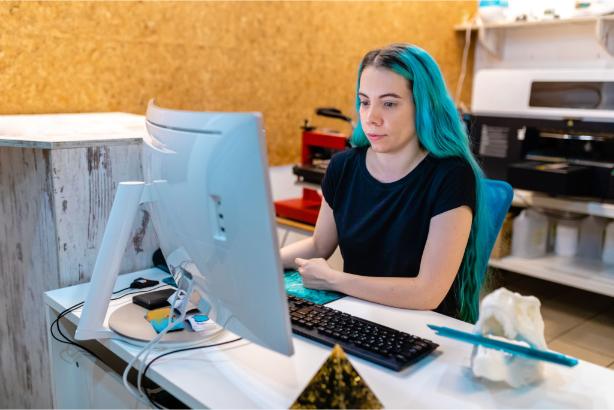Backgrounds on websites are like air for the body. We use them on a regular basis, but we rarely give them much thought unless something seems obviously wrong. Web page backgrounds, like oxygen, are essential to the survival and flourishing of your site. They improve the performance of the whole.
What are website backgrounds, anyway?
Backgrounds for websites are the visual elements that cover the entire page. In many cases, this is the first time a visitor encounters your website, brand, or company. The right setting will tell your brand’s story, while the wrong one will confuse your audience. To use an analogy, think of your website’s background as the outfit you’d wear on a first date or at a job interview. Whether you’re dressing up or going out, do you want to appear friendly and approachable, or exclusive and chic?
In reality, there is far more to this seemingly elementary facet of web design than meets the eye. It is not sufficient that the background of your website be aesthetically pleasing. As with a first date or job interview, it’s important to introduce yourself, make sure the meeting location is convenient, and make the other person feel comfortable. Backgrounds on websites should also be legible and contribute to a positive User Experience (UX).
Website background basics
Getting a firm grasp on the fundamentals is mandatory before diving into the suggestions.
Meet the two types of website backgrounds
The body background
The majority of the display is taken up by the body background. You can find gradients of colour here, as well as backgrounds that are illustrations, textures, or full images. It’s usually just a flat white colour.
The content background
In contrast to a typical background, the content background in this case does not fill the entire display but rather frames the edges of the visible content, be it an image or some written words. It helps organise the site and draws attention to key parts.
Use headers for extra pop
The header, or top section of a web page, is a great place to inject some character into the overall design. It’s a great spot to employ attention-grabbing elements, such as illustrations or a splash of colour, without fear of detracting from the content underneath.
Pay attention to contrast
Remember to think about how colours contrast with one another. Be sure to check your contrast ratio to ensure your website’s readability for visitors. Poor contrast can make text unreadable.
Go graphic
By incorporating images and other visual elements into your website, you can give it a unique feel and convey information with just visuals. Make sure the graphics you use fit the theme of your site to give visitors a unified impression of your business.
Beef up your background
When designing a website, a white background is classic and understated. However, when done properly, full-screen backgrounds in web design (such as a gradient, full image, or solid block of colour) can make a big impact. You want to avoid having the image itself serve as a distraction, so make sure it’s not too bright or has any dark areas. It’s crucial that users are able to quickly and effortlessly absorb the essence of your company.
Say hello to highlights
To improve readability, use highlights (very thin lines made up of different colours to separate sections of your website) to break up large blocks of colour.
8 tips for creating your ideal website background
1. Use clever color UI
Background colours in web design have an effect on how easy or difficult it is to read the text on the page. Color is a powerful tool that can be used in web design to attract users, evoke specific feelings, spark curiosity, motivate action, and ultimately increase sales and customer satisfaction.
2. Make your background image super readable
The ideal background image is attractive in and of itself, but also enhances the visual appeal of your text or video. There’s no point in picking a stunning image for your website’s background if you can’t make out the text against it. You can use photo editing software or CSS to change things like contrast, opacity, or even add layer masks if you’ve found the perfect image but your text isn’t legible over the content. If that isn’t working, then maybe you should try adjusting the font and size to fit the text.
3. Give solid color backgrounds a go
You can’t use that photo on your website, right? Use a single, consistent colour as your website’s backdrop. Provided the contrast is adequate, this is a fantastic method for making sure your website is readable. The colour should complement your company’s identity, your industry, and the image you wish to project. For instance, fitness-oriented brands could benefit from the energising effect of red and pink, while the calming effect of green and blue makes them the most popular website colours.
4. Avoid busy and cluttered images
When superimposing text on an image, this is crucial. The image you choose for your website should be eye-catching, but it shouldn’t detract from the message or narrative you’re trying to convey. Pictures of landscapes, for instance, can serve as attractive and unobtrusive background images for websites.
5. Make it trendy
You can make your website look modern and up-to-date by using a background that features a trend. You could try using the current Pantone colour of the year, or the dark mode, or geometric shapes, or immersive 3D elements, or glowing, luminous colour schemes, or even just the regular old colour black. If you choose a trendy background instead of a more classic one, you may need to change it out sooner rather than later.
6. Get animating
Having an animated background on your website is a great way to make it more engaging. Just make sure the animation isn’t too flashy, as that will detract attention from the primary focus of the design (the image or message). Due to the lively nature of animation, a muted colour scheme can be effective.
7. Go with a gradient
Yes, the most popular design trend of the 1990s is making a comeback: gradients. Gradients, also called colour transitions, are smooth, gradual changes in hue. They add visual appeal and versatility, working equally well as a background on their own or as a layer over a photo to enhance the overall effect.
8. Make it mobile friendly
Time: 2020 Despite the fact that you may be creating your site on a desktop computer, the vast majority of website visitors are accessing the web via mobile devices. To ensure your website is accessible on mobile devices, please keep in mind the following guidelines.
- Make your site mobile-friendly.
- Facilitate access to commonly sought after details.
- Stay away from Flash.
- Take advantage of the viewport meta tag.
- Activate the form’s auto-fill function.
- Ensure that the button sizes are sufficient for use on mobile devices.
- Make the font size very large.
- Images and CSS should be compressed.
It’s important to choose a background image for your website that will scale well to different screen sizes. For instance, a handheld device may not be able to display a particularly wide image.
How to get the website background of your dreams
Having a beautiful background image on your website can make it stand out from the crowd. Keep in mind that the experience of your site’s visitors is of the utmost importance, and design the site accordingly, paying close attention to details like the legibility of text over a background image.
To maintain a cutting-edge aesthetic, it’s a good idea to use gradients and geometric shapes, as well as solid backgrounds. If you want to stand out from the crowd, try your hand at animation, and use a background that adjusts well to different screen sizes.
Don’t forget that there are no hard and fast rules when it comes to design. In fact, sometimes breaking the rules entirely results in the most successful designs. The experience of your users is of paramount importance. Take these suggestions as a jumping-off point, but ultimately trust your own creative instincts.


